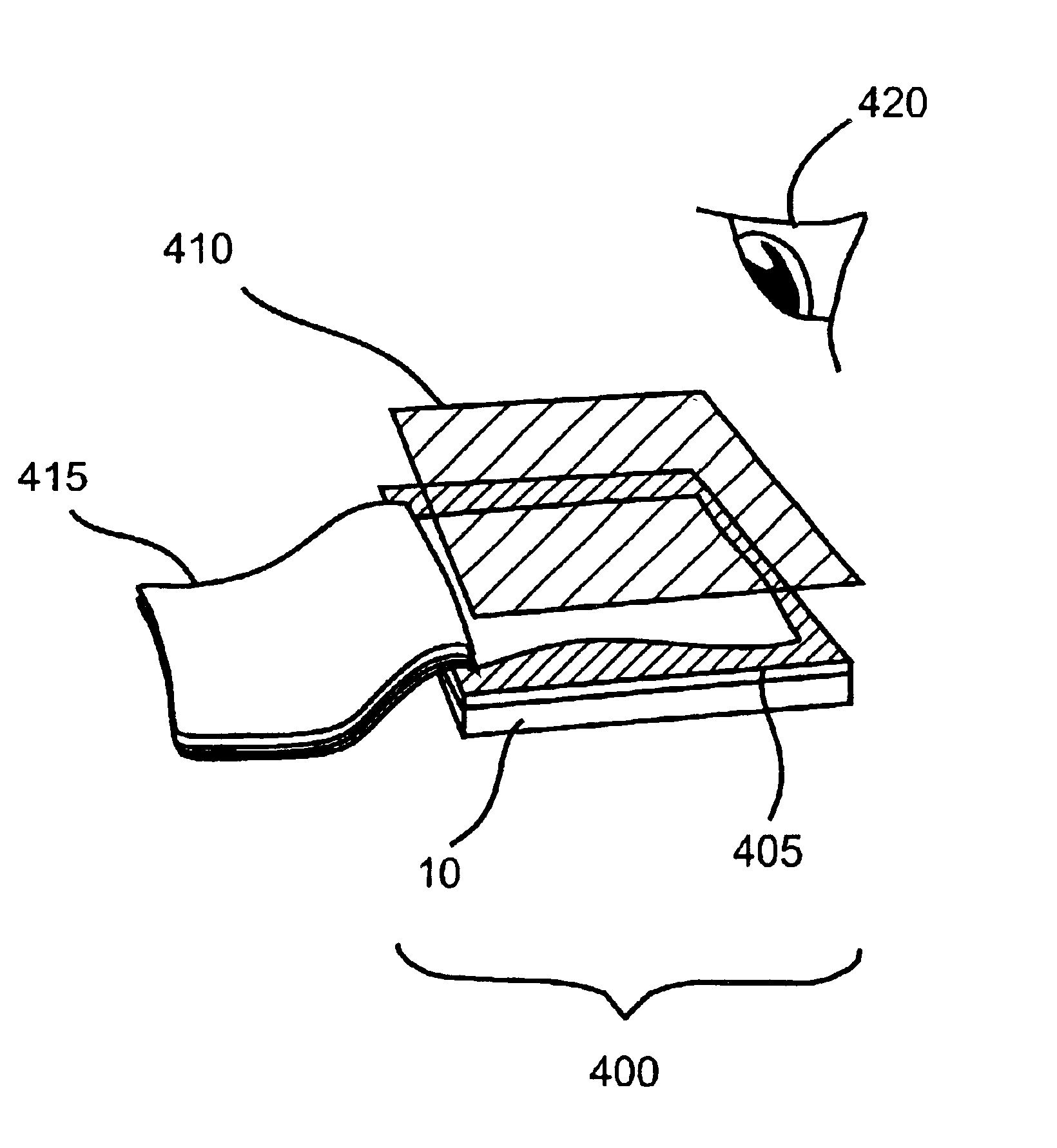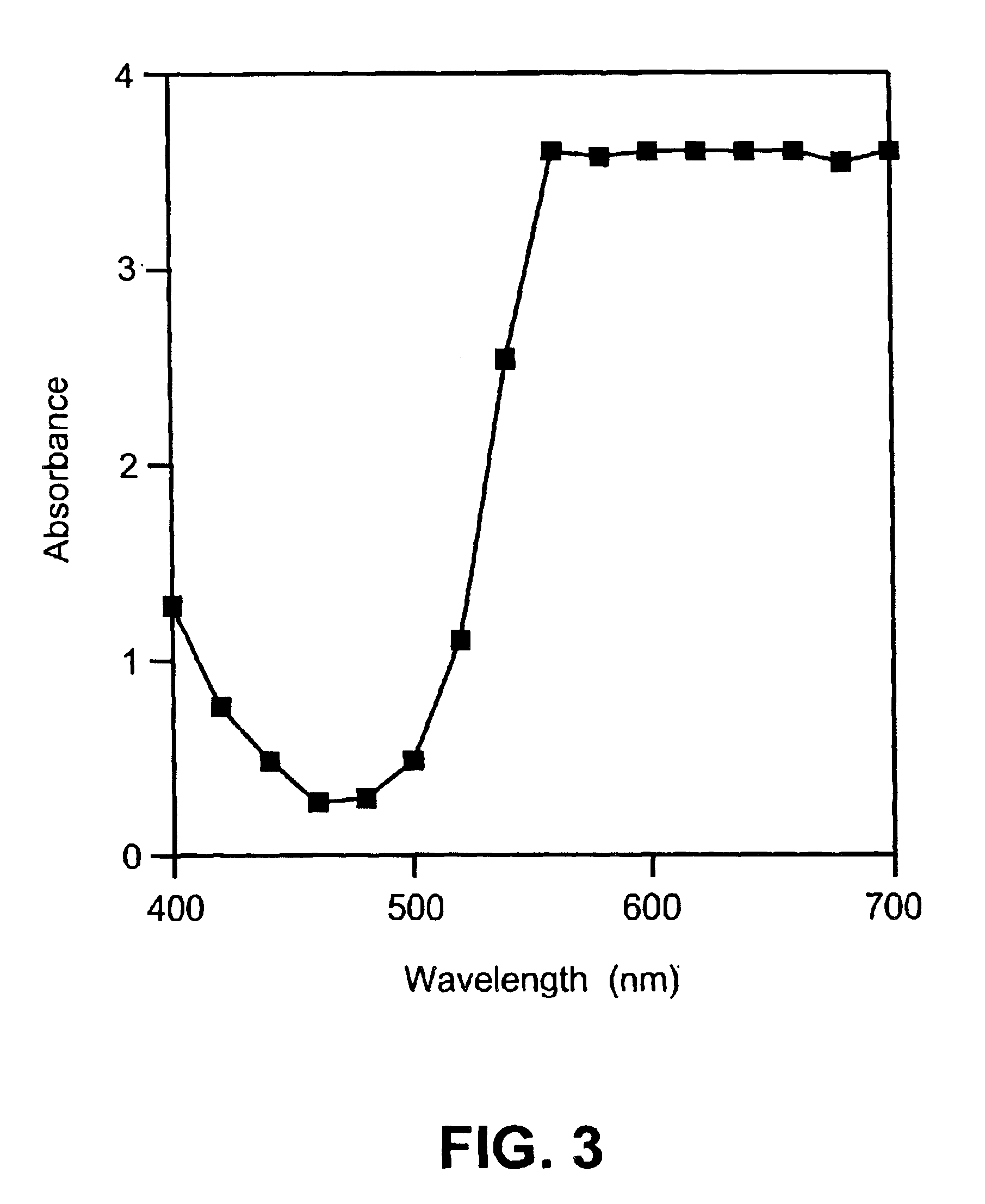Fluorometric detection using visible light
a fluorometric and visible light technology, applied in the field of can solve the problems of skin tissue damage, dna sample damage, and the use of laser light is not applicable to the simple and direct viewing of dna gel by the human eye, so as to reduce the occurrence of photo-bleaching, reduce degradation and modification of fluorescent materials, and avoid damage to fluorescent and phosphorescent materials.
- Summary
- Abstract
- Description
- Claims
- Application Information
AI Technical Summary
Benefits of technology
Problems solved by technology
Method used
Image
Examples
example 1
Sensitivity
[0195]The sensitivity of an optimized device of this invention was measured by detection of known quantities of DNA on gels stained with SYBR® Green I and ethidium bromide, both by eye and by photography. What is seen by the eye and what is recorded on photographic film are not necessarily one and the same, especially when using black-and-white photography. For example, photographic film is able to accumulate an image over many seconds and, after processing, the image can be quantitated. On the other hand, the interpretative skill of the human eye when directly viewing an image is unparalleled. Though scientists use photographs of DNA gels for their laboratory records and for detailed analysis such as calculation of the sizes of DNA fragments, much of the analysis of a DNA band pattern on a gel is achieved using the naked eye. Furthermore, the excision of gel slices containing DNA is always done by eye. Therefore, it is important that the sensitivity of any apparatus for ...
example 2
Blue Compact Fluorescent Lamps and SYBR® Gold
[0225]Various dilutions of a DNA cut with HindIII (Boehringer Mannheim) in 10 mmol / L Tris-Cl, 1 mmol / L EDTA were incubated at 60° C. for three minutes. The samples were placed on ice and sample loading buffer (0.25% bromophenol blue, 0.25% xylene cyanol, 15% Ficoll type 400 in 10 mM Tris-Cl, 1 mmol / L EDTA, pH 7.5) was added to each mix. Various amounts of the DNA samples (from 428 ng to 0.85 ng) were loaded onto a 1% agarose gel 7.6×12.7 cm (3″×5″ in.) in 89 nmol / L Tris borate, pH 7.82, and 2 mmol / L EDTA (TBE). The gel was run at 80 V for two hours and then placed in 100 mL of 1:10000 dilution (in TAE) of SYBR® Gold for 30 minutes. The gel was photographed using a Polaroid® camera (Polaroid Corporation, Cambridge, Mass. with Polaroid 667 film on either a Fisher UV 312 nm variable intensity transilluminator (Fischer Scientific, Pittsburgh, Pa., Model No. FBTTV-816), set to maximum intensity in all cases, a Wratten #12 on the camera, f-stop...
example 3
Ethidium Bromide Gel
[0230]DNA cut with HindIII (Boehringer Mannheim) in 10 mmol / L Tris-Cl, 1 mM EDTA was mixed with sample loading buffer and various amounts of DNA (from 125 ng to 15.6 ng) were loaded onto a 0.7% agarose gel (3″×5″) in TAE. Ethidium bromide was added to both the gel and running buffer to a final concentration of 0.25 μg / mL. The gel was run at 110 V for two hours and then examined by eye and photographed using a Polaroid camera with Polaroid 667 film on either a UV 312 nm transilluminator (Fisher Scientific) set to maximum lamp intensity using a red Tiffen 40.5 mm 23A filter (Tiffen Manufacturing Corp., Hauppauge, N.Y.) on the camera (f-stop=5.6, exposure time=2 seconds) or an embodiment of the present invention as depicted in FIG. 9 equipped with a CF9DS / blue lamp, a #668-0GP first filter, and a Perspex® #300 second filter. A Wratten #21 (Kodak) was used as an additional second filter for photography (f-stop=5.6, exposure time=30 seconds). The gel was also observed...
PUM
 Login to View More
Login to View More Abstract
Description
Claims
Application Information
 Login to View More
Login to View More - R&D
- Intellectual Property
- Life Sciences
- Materials
- Tech Scout
- Unparalleled Data Quality
- Higher Quality Content
- 60% Fewer Hallucinations
Browse by: Latest US Patents, China's latest patents, Technical Efficacy Thesaurus, Application Domain, Technology Topic, Popular Technical Reports.
© 2025 PatSnap. All rights reserved.Legal|Privacy policy|Modern Slavery Act Transparency Statement|Sitemap|About US| Contact US: help@patsnap.com



